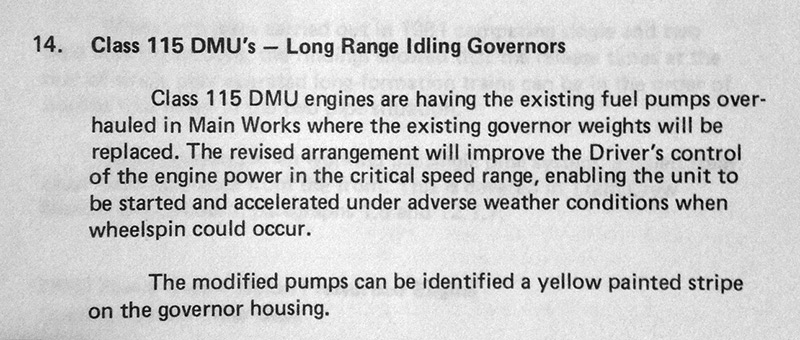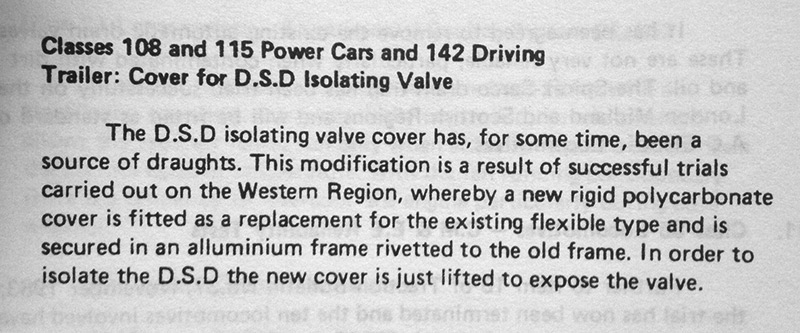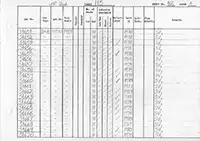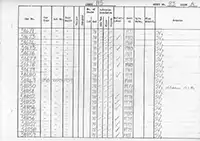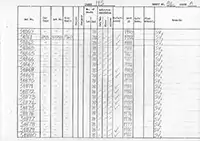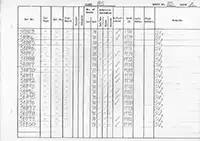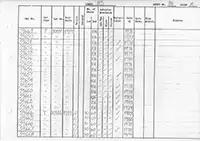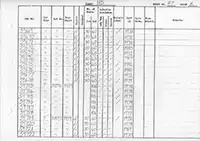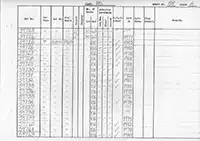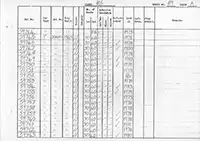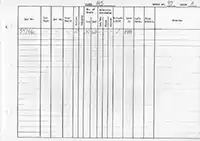Class 115 Derby 4-car DMUs
Description
While the vehicles appeared externally similar to Class 127 vehicles, there were minor differences. The Class 115s had four handrails on the cab front, the Class 127s had none. The Class 115 TCL vehicle had a slightly different window layout than the Class 127 TSL vehicle, with one full size window being replaced by two half windows where a bulkhead divided the first class area into smoking / non-smoking.
Internally they had improved seating, furnishings, lighting and wall surfaces, due to the work of the BTC Design Panel who wanted to remove the bus type atmosphere from the sets.
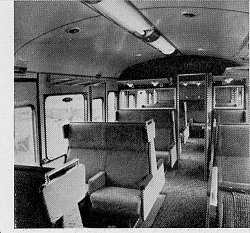
This is the first class.

This first view of a second class has an unpatterned moquette (the scan has added the dots).
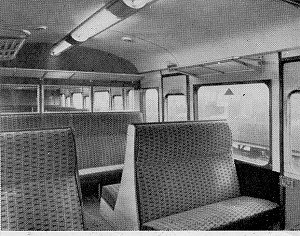
This view of a second class non-smoking saloon shows moquette that was also used on the Class 126 Swindon units built for Ayrshire.
Only the third batch had alloy window frames.
Over the years the sets had a variety of buffers, including cut, oval and large round. In 1981 some power cars were fitted with power sanders to aid adhesion.
Modifications
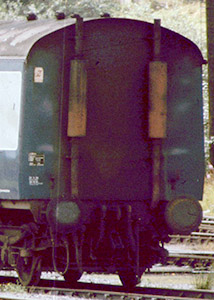
Exhausts
On the rear end of the power cars the exhausts were plain pipes rising up to join into a single box - see this image. Beginning in 1965 alterations began to be made so the pipes no longer joined. By circa June 1965 at least seven vehicles had this done: 51654/62/74, 51865/81/4/95[1]. By mid-1966 51653/4/6/8/9/60/2/7/74/5/8/9, 51862/5/6/9/70/4/5/6/81-4/6-9/95/7/9 and 51900 had been treated.[2]
In mid-1976 two power cars (one being M51857) were fitted with a new type of exhaust silencer as an experiment. It included an expansion chamber equal in volume to the swept volume of the engine, fitted as close to the exhaust manifold as possible with large-diameter pipe leading to an increased-capacity exhaust silencer. The level of exhaust noise usually associated with these units was significant reducted in initial tests[3].
Later on the exhausts had an additional sliencers added on the inner ends, as shown in the image.
Tail Lights
In late 1975 red bulbs were fitted to one of the two positions on each of the cab marker-lights, to operate as tail lights to that tail lamps were no longer required.[4]
Sanding Gear
David Hatt was a commuter to and from Amersham in Autumn 1978: "One evening the 17:12 from Marylebone to Aylesbury stalled on Chorleywood bank due to leaves on the rails. I was waiting on Amersham station and watched a Class 25 pass southbound to rescue the DMU. London Transport were not best pleased by this incident, since it completely disrupted the Metropolitan Line service in the evening peak. For the next several weeks, DMUs were not permitted to run over the Metropolitan Line, and so BR operated an Aylesbury to Amersham shuttle."
"The first modification to the Class 115s was the fitting of a funnel in the guard's van, with a hose down to the bogie. This allowed the guard to pour sand into the funnel, thus facilitated sanding at the wheel/rail interface. I have a feeling that it was this modification, implemented quite quickly, which convinced London transport to lift their ban on DMUs running over the Metropolitan Line. It was either the following year, 1979, or 1980 that the sandboxes started to appear on the bogies."[5]

The image shows this sanding gear fitted to the front bogie of M51656. The sandbox can be seen to the right of the left hand axle with a pipe to discharge the sand under the wheel.
Gangways
Vehicles began to be gangwayed in October 1986, to create hybrid 115 DMBS/108 DTCL sets for Network South East. The first two treated were 51654 and 51878 with the work being done at Tyseley[6]. The former would be transferred from Allerton to Marylebone during this time, they would be paired initially with 54222 and 54259 which had their first class accomodation re-instated.
The next two cars, 51849 and 51855, were curiously re-allocated from Allerton to Tyseley (on 12/11/86), where the gangways were fitted (noted there on 1 December [7]), then transferred to Marylebone on 7 January 1987 and 22 December 1986 respectively.
The full list of the ME/BY vehicles, and approximate conversion dates where known:
51651 (2/87), 51652 (4/87), 51654 (10/86), 51656 (7/87), 51657 (7/87), 51661 (8/87), 51676 (2/87), 51679 (4/87), 51849 (12/86), 51855 (12/86), 51866 (7/87), 51878 (10/86), 51893 (1/87), 51895 (3/87)
Three other Marylebone vehicles 51655, 51663 and 51886 (all 3/87) were recorded in some sources[8][9][10][11] as being gangwayed. This was possibly from an error in the BR stock lists, 51655 did not have a gangway in preservation and none of the three were noted as paired with a Class 108 DTCL as the above were.
Vehicles (power cars and centre cars) transferred to Tyseley would also be gangwayed. Many of the vehicles remaining in the London area would remain ungangwayed.
Other Modifications
Here are details of some of the many other modifications made to the class, detailed in LMR Traction Bulletins:
Issue 4 - October 1972
Issue 36 - May 1983
Issue 39 - August 1984
Asbestos
The vehicles were built without blue asbestos. They were included in a vehicle log kept by the RTC at Derby dated circa 1984 which included the asbestos status for each vehicle, the pages of which are included below.
In the asbestos columns the / meant they were not built with blue asbestos, in the remarks column SV meant seperate van (no access to train).
References
- ⋏ p277 August 1965 Railway Observer
- ⋏ p268 August 1966 Railway Observer
- ⋏ Diesel unit silencing trials, p324 August 1976 "Modern Railways" (Ian Allan)
- ⋏ p26 January 1976 Railway Observer
- ⋏ Email David Hatt to Stuart Mackay 4 February 2021
- ⋏ "Multiple Matters", p30 January 1987 Rail Enthusiast magazine
- ⋏ "Multiple Matters", p30 February 1987 Rail Enthusiast magazine
- ⋏ p194 May 1987 Railway Observer
- ⋏ p10 Multiple Unit Pocket Book Winter 1988 Edition, Platform 5 Publishing
- ⋏ p12 Multiple Unit Pocket Book Summer 1988 Edition, Platform 5 Publishing
- ⋏ p12 Diesel Unit Pocket Book 1989 Edition, Platform 5 Publishing
The Railway Observer is the journal of the Railway Correspondence and Travel Society
Summary
Description
Diagrams & Works Photos
Refurbishment
Numbering & Driving Inst.
Liveries
Operations
- Manchester - Liverpool
Images
Details about preserved Class 115s can be found here.




